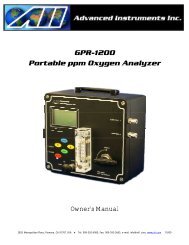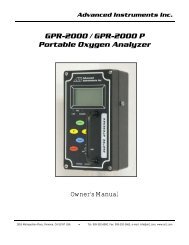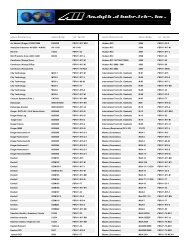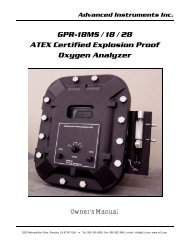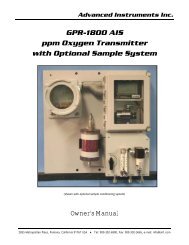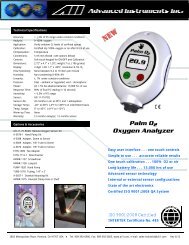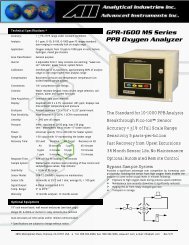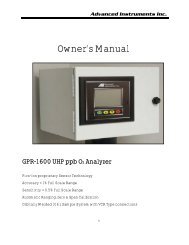GPR-2600 Series Oxygen Analyzer - Advanced Instruments Inc.
GPR-2600 Series Oxygen Analyzer - Advanced Instruments Inc.
GPR-2600 Series Oxygen Analyzer - Advanced Instruments Inc.
You also want an ePaper? Increase the reach of your titles
YUMPU automatically turns print PDFs into web optimized ePapers that Google loves.
<strong>Advanced</strong> <strong>Instruments</strong> <strong>Inc</strong>.Span Gas Selection:The O2 concentration of a span gas should approximate 70-90% of the full scale rangedictated by the span gas, e.g. 20.9% O2 on the 0-25% range. For optimum accuracy, thefull scale range dictated by the span gas should be at least one range higher than theintended analysis range. Both of the aforementioned recommendations reduce the errorinduced by the tolerance of the electronic components; also, span gases with higher O2concentrations are more reliable and less expensive.Conversely, if the recommended span gas is not available and air calibration is not anoption, a span gas of the same full scale range and near the anticipated analysis level(approximately 10% of full scale) is acceptable with the understanding the accuracy willsuffer slightly.Use of span gas near 10% of the same full scale range for measurements at the higher endof the range has the effect of “expanding the error” by moving upscale as illustrated byGraph A and Example 1 in the Accuracy section above and is not recommended. Of coursethe user can always elect at his discretion to accept an accuracy error of +2-3% of full scalerange if no other span gas is available.Type of Sensor:Galvanic Fuel Cell Sensors: <strong>Analyzer</strong>s utilizing these sensors can be calibrated withambient air (20.9% or 209,000 ppm O2) and have been proven capable of precise analysisbelow 0.5 ppm (500 ppb).Note: As described above, these oxygen sensors are capable of one point calibration.Span Gas vs. Air(Fuel Cell Sensors only):Span gas calibration: Recommended for calibration of in-service analyzers, if the priorityis the fastest online recovery time.Air calibration: Recommended for calibration an analyzer if a new oxygen sensor is beinginstalled or if the availability of span gas, the cost of span gas or the accuracy of a span gasis an issue. An air calibrated analyzer can be used to reliably verify a “certified” span gas,which has frequently been found to be inaccurate. For best results, select a recognizedname supplier.Note: Galvanic Fuel Cell sensors can be calibrated (using air) and brought online (usingsample gas) without “purchased calibration gases” and without sacrificing accuracy -provided the analyzer is given enough time to come down to the O2 concentration of thesample gas.Span CalibrationAdjustments:Prematurely initiating the SPAN CALIBRATION function (when there is no intention ofperforming a ZERO CALIBRATION) before the analyzer reading has stabilized can result inerroneous readings as follows:When purging an analyzer to lower ranges for span gas calibration: If the oxygenreading reaches less than 2% of the intended calibration range, enter the value of the spangas. If the oxygen reading is greater than 2% of the calibration range, add the O2 readingto the value of the span gas (the impact of the offset on accuracy is minor but the additionallows the oxygen sensor to continue to purge down and avoid negative readings).Note: If ZERO CALIBRATION has been performed or the analyzer has been in service, theanalyzer reading should already be stable and below 2% of the calibration range.When installing a new oxygen sensor and calibrating with air: Allow 5-10 minutesfor the sensor to equilibrate in ambient air from storage packaging. Failure to do so canintroduce a positive offset (electronic gain) that prevents the analyzer from displaying lowppm O2 readings.33



